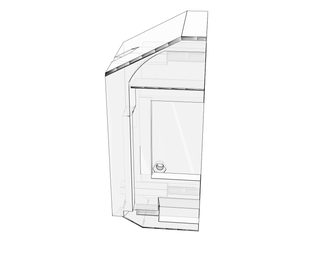Introduction: Battery Adapter Makita LED Sled Lamp
Few weeks ago, i added a lamp to my new sled. I live in Munich and sometimes in the evening i drive into the alps, walk up a hill and ride down. I have a normal engineer job so its dark when i finish in the winter.... additionally compared to the skiing hills the ways for sleding are normally not illuminated. And mostly they are located in the forest - its very dark....
That was the problem. My solution was to use my 3Ah Makita 18V Battery BL1830 in combination with a LED-Working-lamp and some 3D-printed parts. I use these batteries normally for my cordless drill and jigsaw. The working lamp is designed for trucks, construction and agricultural vehicles. Its driven only from the trucks battery voltage so it contains all the electronics(constant current regulator, over-voltage fuse, step/stepup converter) So its no problem to power it with 18V. In Europe trucks have a 24V battery system compared to the U.S. with 12V. But the electronics of that lamps often are able to handle voltages between 9-32V.(due to under- and overvoltage during the ignition phase.) Not all the lamps are so safe, especially not the very cheap ones) Additionally they are often watertight and very rigide. Ideal for Outdoor-applications. Good brands in my opinion are: Hella from Germany, ABL from France, Truck-lite from UK/US, Weldex, Kompled from Germany....and many more.
In the next two steps i want to talk about how to choose a LED-Lamp... If you are only interested in the 3D-printed part - switch to step 3...
Step 1: Technical Parameter of a LED Lamp
For LED-Lamps in this use case the performance is the most critical point. The best value to measure the performance of a lamp is its light flux (luminous flux)measured in lumen. Candela and all the other values are also ok, but they depend on the angle(beam pattern) and are not so good to compare.
A halogen bulb (H7) for car headlamps has around 1500lm. It has a power consumption of 55W. The efficiency is at 27 lm/W.(1500lm/55W) Thats very good for a halogen bulb. But its only the efficiency of the bulb. The headlamp(reflector/lens) is not considered...
State of the Art LED Chips have a efficiency of around 130 lm/W!(in theirworking state) (check out the latest products of cree, osram, nichia, luxeon) (You have to be aware - these values are often measured in 25 ms - which is not a working state.... and often only for the best lot(bin).
So if you want to buy a LED Workinglamp you have to look at the power consumption and the luminous flux and calculate... The problem is, that the supplier often tell you only the efficiency of the LED-Chip and not the hole lamp.
For example any glas optics has at every surface a light loss of 4% due to the refraction law. Every reflective surface has a reflectance grade of max 95%...
In addition to that there is another physics law which is called Etendue. Thats the main reason for a low optical efficiency. The summary of all these losses is, that you will have a max optical efficiency of around 50 to 60%. Multiplied with the 130 lm/W a good lamp will have a around 80lm/W. Lumen at the illuminated surface.
Hella for example says that they give you the values for the hole lamp. For example the "Ultra Beam LED Gen. II" has a power consumption of 56W and a luminous flux of 4000lm. That means its efficiency is at around 70lm/W - a value i would trust and which is ok. And thats very bright!
I recommend for the sled a lamp with 10-20W.
Step 2: Technical Parameters of the Battery
The technical parameters of a battery should be considered as the product of voltage and capacity. My batteries have a voltage of 18W and contain a capacity of 3Ah. That means that they contain 18V*3Ah=54Wh.
3Ah means that you can power a LED Lamp with 18W at 18V for 3 hours. Because the lamps needs then a current of 1A.(18V*1A=18W). If you use a 54W LED Lamp- you only can power it 1 hour.(54W/18V=3A)
These values are only theoretical but should be considered, choosing a LED Lamp. Theoretical due to the fact, that the capacity depends of the age of the battery temperature and so on...
Step 3: Battery Adapter
For the Makita battery i designed a adapter which i can print at my 3D-Printer. The contacts to connect the batteries are not fixed, so that they dont apply a force to the batterie. The contacts are made of a piece of copper i got from a copper pipe.
I designed the part in two sperate parts, so thats easier to print(with low overhang) and assembly.
Step 4: Lampholder
The sled is traditional sled which has the ability to steer it with the leg and weight of the driver. Due to that the skid are flexible and i decided to fix the lamp only at one skid.
A piece of a bicycles inner tube increases the friction and compensates some mechanical differences.
Four M4x45mm Bolts clamp it to the skid. The bore holes contain a hexagonal shape for the hex-nuts.
The holder also contains a flange for cable zip ties to mount the battery.
Step 5: Result
I am very happy with the result. It contains all the features i wanted and i cant wait to test it.... foolishly its to warm now...
A additional feature is, that i have now a battery adapter i can use also for other projects....including a bright LED-Lamp.

Participated in the
Make it Move Contest 2016

Participated in the
3D Printing Contest 2016


















